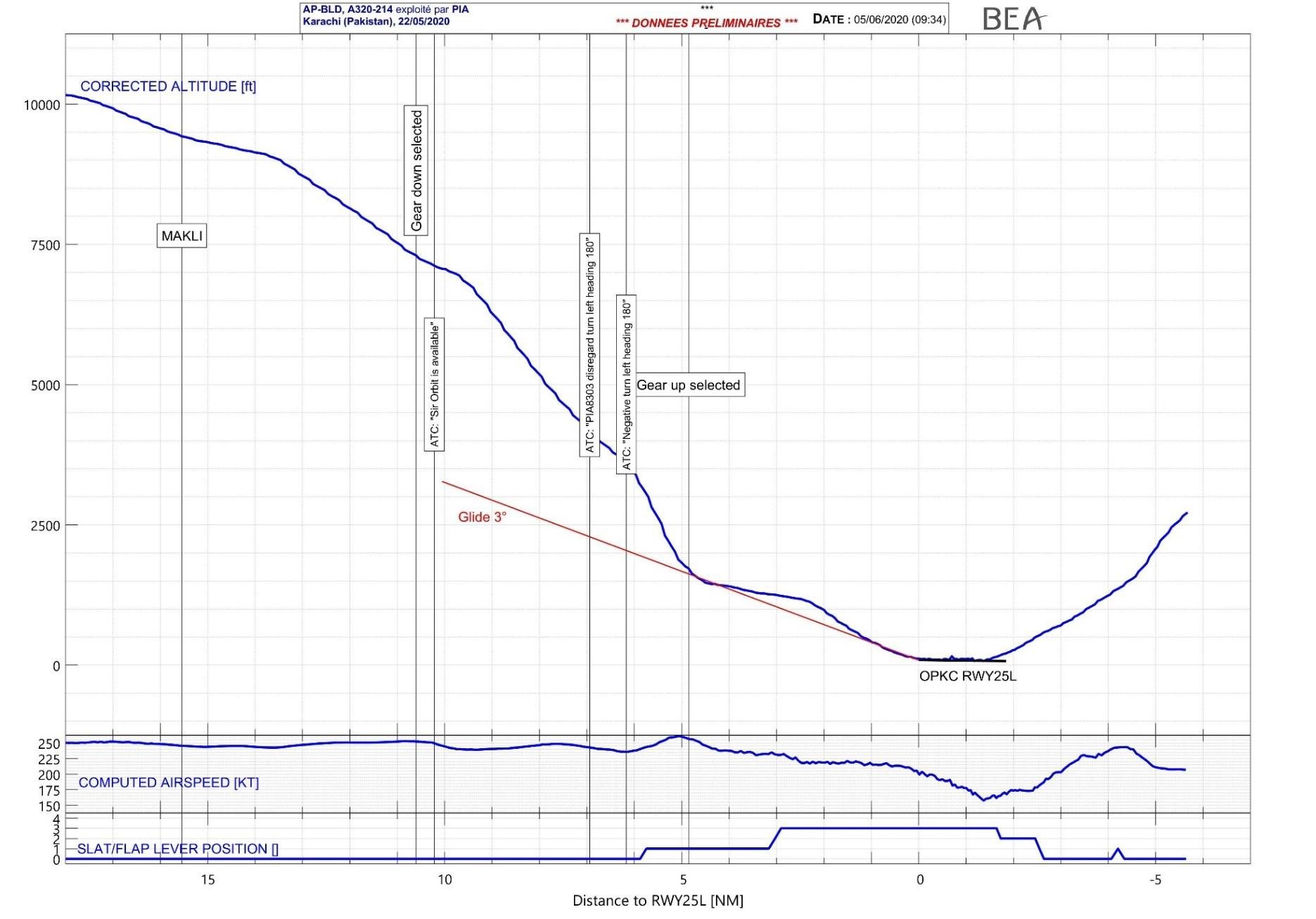Click Here to View This Page on Production Frontend
Click Here to Export Node Content
Click Here to View Printer-Friendly Version (Raw Backend)
Note: front-end display has links to styled print versions.
Content Node ID: 401854
Pakistan’s Aircraft Accident Investigation Board (AAIB) released the preliminary report about the crash of state-owned Pakistan International Airlines (PIA) Flight PK8303 on May 22, 2020. While the report, published late on June 24, didn’t specifically blame the pilots for the accident, it summarized information about the Airbus A320’s last flight, in which 97 of the 99 people on board died. Four people on the ground were injured, one of whom later died.
Among the proposed next steps for its investigation, AAIB said it intended to look more closely at aircrew records, "related to their medical fitness, licensing, training records and personal documents." The agency also indicated it will look at PIA's crew scheduling and rest process for the month prior to the accident.
It has been reported—although not confirmed by PIA—that the airline is purging pilots with questionable qualifications. According to a June 25, Associated Press story, PIA is grounding 150 pilots because they are suspected of cheating on tests “by having others take exams for them.” The AP story added that Ghulam Sarqar Khan, Pakistan’s aviation minister, revealed during a presentation to parliament about the accident that “262 out of 860 Pakistani pilots had ‘fake’ licenses.”
Following the issuance of the report, PIA made this statement via Twitter: “PIA acknowledges the AAIB report and has already taken measures learning from it. An independent Flight Data Monitoring setup established to monitor & analyze all flights. All pilots with dubious licenses will be grounded. Safety is more imp. than any commercial interest.”
PK8303 took off from Lahore, Pakistan, on May 22 and at about 14:35 began the ILS approach to Karachi Jinnah International Airport’s Runway 25L. After being cleared by air traffic control (ATC) for the Nawabshah 2A arrival, PK8303 was cleared to descend to 10,000, then 5,000, and finally 3,000 feet before reaching the MAKLI waypoint.
Instead of having the A320 properly configured and at the specified altitude for the approach, when it reached MAKLI, the A320 was at 9,780 feet and 245 knots indicated airspeed. Rather than fly a go-around maneuver from this unstabilized approach, the pilots elected to continue the approach. They selected “OPEN DES” (open descent) mode on the Airbus’s flight control unit (mode controller), disconnected the autopilot, and extended the speed brakes, according to the AAIB report. After the Karachi approach controller suggested that the pilots “take an orbit” (fly in a circle) to help regain the desired descent profile, the pilots continued straight “and the effort to intercept the glideslope and localizer (of ILS) was continued.”
According to flight data recorder (FDR) information, the pilots extended the A320’s landing gear at 7,221 feet about 10.5 nm from Runway 25L. The approach controller twice suggested the pilots discontinue the approach and warned them about the excessive altitude. Inexplicably, the pilots retracted the landing gear at 1,740 feet, then the speed brakes, and at this point, the A320 was about half a nautical mile from the runway. Still at high speed, although on glideslope and localizer, the pilots selected Flaps 1 at 243 knots. With the landing gear and speed brakes still retracted, the A320’s overspeed and enhanced ground proximity warning system warnings were triggered, the report stated.
Apparently events were moving too fast for the approach controller to hand the pilots off to the tower (aerodrome control), so the controller quickly telephoned aerodrome control to get a landing clearance. The tower controllers cleared PK8303 to land but didn’t say anything about the fact that the A320’s landing gear was retracted, or they didn’t notice, as it continued descending toward the runway.
The A320 was clearly flying an unstabilized approach as the FDR recorded at 500 feet that the landing gear was retracted, slats/flaps were in configuration 3, airspeed was 220 knots (nearly 100 knots above typical approach speeds), and descent rate a high 2,000 fpm. Several warnings and alerts were captured by the FDR and cockpit voice recorder, including overspeed, landing gear not down, and ground proximity. The report noted, “The landing was undertaken with landing gears retracted. The aircraft touched the runway surface on its engines. Flight crew applied reverse engine power and initiated a braking action. Both engines scrubbed the runway at various locations causing damage to both of them.”

For unknown reasons, the pilots elected to try to take off and amazingly managed to get the A320 back into the air. According to the report, although the tower controllers saw the engines scraping and sparking on the runway, they did not relay this information to the pilots, although they did telephone Karachi Approach to let them know.
The FDR recorded that the pilots after taking off lowered the landing gear but then immediately retracted it. They asked to fly another approach to Runway 25L. Then one engine failed and another and the ram air turbine deployed to provide backup power to essential systems. At some point, the landing gear was again lowered. Slats were in position 1 while flaps were retracted. After declaring an emergency and making a mayday call, the pilots tried to make it to the runway but crashed 1,340 meters short into a populated area.
There was no evidence of any problems with the aircraft, according to the report, which added, “Captain and first officer were adequately qualified and experienced to undertake the said flight; necessary scrutiny of the aircrew records/documents is underway.”